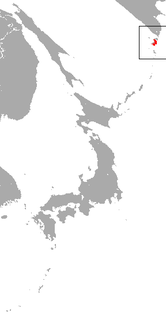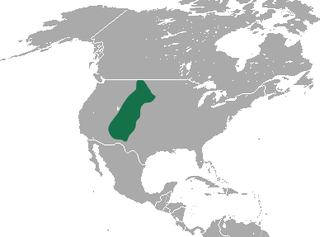
The red-toothed shrews of the subfamily Soricinae are one of three living subfamilies of shrews, along with Crocidurinae and Myosoricinae. In addition, the family contains the extinct subfamilies Limnoecinae, Crocidosoricinae, Allosoricinae and Heterosoricinae. These species are typically found in North America, northern South America, Europe and northern Asia. The enamel of the tips of their teeth is reddish due to iron pigment. The iron deposits serve to harden the enamel and are concentrated in those parts of the teeth most subject to wear.

The marsh shrew, also known as the Pacific water shrew, Bendire's water shrew, Bendire's shrew and Jesus shrew is the largest North American member of the genus Sorex. Primarily covered in dark-brown fur, it is found near aquatic habitats along the Pacific coast from southern British Columbia to northern California. With air trapped in its fur for buoyancy, marsh shrews can run for three to five seconds on top of the water. It measures about 16 cm (6.3 in) in length, including a 7-centimetre (2.8 in)-long tail, and weighs an average of 14.5–16 g (0.51–0.56 oz). The marsh shrew's diet consists mainly of invertebrates, which it hunts on land and in the water. They are rare; their populations are thought to be in decline, and they are considered endangered in parts of their range.

The smoky shrew is a medium-sized North American shrew found in eastern Canada and the northeastern United States and extends further south along the Appalachian Mountains.

The genus Sorex includes many of the common shrews of Eurasia and North America, and contains at least 142 known species and subspecies. Members of this genus, known as long-tailed shrews, are the only members of the tribe Soricini of the subfamily Soricinae. They have 32 teeth.

The tundra shrew is a small shrew found in Alaska, the northern Yukon Territory, the MacKenzie Delta region of the Northwest Territories, extreme northwestern British Columbia and eastern Russia. At one time, this animal was considered to be a subspecies of the Arctic shrew.

The Eurasian pygmy shrew, often known simply as the pygmy shrew, is a widespread shrew of the northern Palearctic.

The Gansu shrew is a red-toothed shrew found only in a small part of Gansu province and other adjacent areas of China. With its very limited range, it is sensitive to habitat loss and is listed as a "vulnerable species" in the Chinese Red List, while the IUCN lists it as being "data deficient"

The Siberian large-toothed shrew is a species of shrew. An adult Siberian large-toothed shrew has a weight of 4.6–6.0 g (0.16–0.21 oz) and a body length of 5.5–6.4 cm (2.2–2.5 in), with a tail of 2.4–3.8 cm (0.94–1.50 in). This species is found across Northeast Asia, from Mongolia through northeastern China to the Russian Far East and the Paektusan region of North Korea.

Baird's shrew is a species of mammal in the family Soricidae. It is endemic to northwest Oregon. Baird's shrew inhabits moist conifer forests.

The Iberian shrew or Lagranja shrew is a species of mammal in the family Soricidae. It is found in Portugal and Spain.

The Saint Lawrence Island shrew is a species of mammal in the family Soricidae. It is found only on Alaska's St. Lawrence Island.

The Paramushir shrew is a species of mammal in the family Soricidae. It is endemic to Russia. Its natural habitat is temperate forests. It is likely named for Paramushir Island, home to several other species of shrew in the genus Sorex.

Merriam's shrew is a species of mammal in the family Soricidae. It is endemic to the western United States and extreme southern British Columbia in Canada.

The dwarf shrew is a species of mammal in the family Soricidae endemic to Arizona, Colorado, Montana, Nebraska, New Mexico, South Dakota, Utah, and Wyoming in the United States. The type locality is Estes Park, Colorado, USA.

The Pacific shrew is a species of mammal in the family Soricidae. It is endemic to western Oregon in the United States. The Pacific Shrew is native to western Oregon, more specifically from the Siltcoos lake to the coast going from the border line of Douglas and Lane counties continuing south to the northern parts of California. The first documented Pacific shrew to be caught was found at the mouth of the Umpqua River in 1858. They are normally found in damp areas along creeks in forests and sometimes near collapsed trees. Their refuge is of the utmost importance and they are seldom found far from it. This includes collapsed trees or dense vegetation. They use the flora to build a nest, gathering small plants such as grass, moss, lichen, or leaves into a pile and pushing themselves into the middle.

Portenko's shrew is a species of mammal in the family Soricidae that is endemic to Russia.

Preble's shrew is a small shrew distributed across the Great Basin of the United States and southern British Columbia in Canada. It belongs to the order Eulipotyphla, family Soricidae and genus Sorex.

Sclater's shrew is a species of mammal in the family Soricidae. It is endemic to Mexico.

Trowbridge's shrew is a species of mammal in the family Soricidae. It is found in southern British Columbia in Canada and in Washington, Oregon, and California in the United States.



















